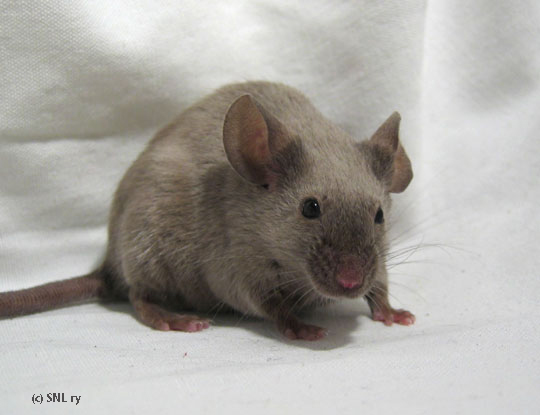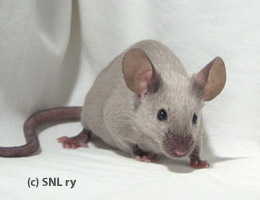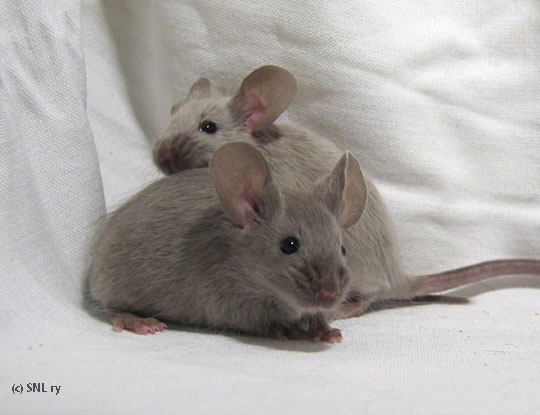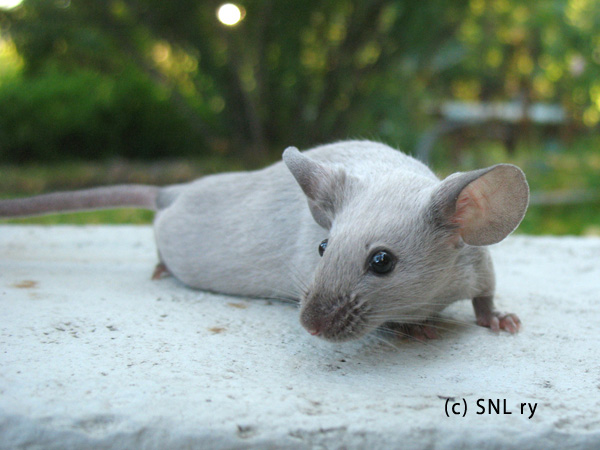Varieties
Shaded and Pointed
Blue burmese (bl-bur)
a/a B/* cch/ch d/d P/*
"Eyes black. The blue burmese is to have light blue body colour all over. The points, which are very dark blue, are like with the siamese blue point."
Breeding information below the pictures.
Text: Anniina Tuura
Blue burmese (bl-bur)
a/a B/* cch/ch d/d P/*
"Eyes black. The blue burmese is to have light blue body colour all over. The points, which are very dark blue, are like with the siamese blue point."
Quick Look
Blue burmese is a burmese mouse with blue dilution (d/d). It has more contrast between body colour and points than burmese, which has made it more popular.
Blue burmese comes in a wide range of shades, varying from very light blue to almost as dark as self blue. The points may be strong or only barely visible. Selective breeding aims at a rather light body colour and as dark points as possible.
Genetic Background
In genetical terms, blue burmese is a non-agouti heterozygous recessive c-locus variety combined with blue dilution. Leaden (ln/ln) is another blue gene that produces blue burmese, but it should be considered secondary as it makes the body colour too dark and brownish.
Being a heterozygous variety, blue burmese doesn’t breed true. This means that mating blue burmese to blue burmese will produce other colours as well and only (statistically) 50% blue burmese.
Getting Started
There shouldn’t be any need to start from scratch if you are interested in breeding blue burmese, because well established breeding lines already exist. In addition to blue burmese, other varieties suitable for breeding blue burmese include siamese blue point (a/a B/* ch/ch d/d P/*) and chinchillated blue (i.e. a blue mouse with two chinchilla genes, a/a B/* cch/cch d/d P/*). Self blue carrying cch or ch may also be used, as well as siamese seal point or burmese carrying blue dilution. With all these it’s important that the mice have the blue dilution and not leaden. Any mice carrying chocolate should be avoided, as they will eventually produce lilac burmese and siamese lilac point.
If the scarcity of blue burmese is a problem, it can be quickly solved if there is just one chinchillated blue male available. Breeding such a male to a group of siamese blue point females will give entire litters of blue burmese, among which there should be enough breeding material to select from.
Breeding
Examples of matings that are most commonly used in breeding blue burmese:
blue burmese x blue burmese
- 25% siamese blue point
- 50% blue burmese
- 25% chinchillated blue
blue burmese x siamese blue point
- 50% blue burmese
- 50% siamese blue point
blue burmese x chinchilloitu blue
- 50% blue burmese
- 50% chinchillated blue
siamese blue point x chinchillated blue
- 100% blue burmese
All these combinations work equally well, given that all the mice have blue burmese backgrounds. However, pairings that don’t produce chinchillated blue may be more desirable, as chinchillated blue may be difficult to tell apart from blue burmese at a very young age. In case there is need to cull the litters by colour, this could be a problem. Chinchillated blue is lighter and more mealy than normal self blue, and is only useful for breeding blue burmese.
Most common faults in blue burmese include dark body colour, light points, mealy or brownish shade and white hairs under the tail. The colour is prone to become darker and somewhat brownish with age. When deciding which babies to keep for further breeding, the breeder should first select for light coloured ones, and as the mice grow, for the ones with darkest points among them. Mice that have dark colour already at young age are not suitable for breeding the variety. The points are “lost” in the dark body colour, and using these darker animals doesn’t usually improve the points if mated to lighter ones either.
If there is a problem with the body colour being too dark, the breeder should first make sure that the breeding animals have the blue dilution and not leaden. Siamese blue point or seal point with strong points and light body colour will help to make the body colour of blue burmese lighter. If seal point is used, the first generation will produce burmese. Light self blue may also be helpful, but it may result in weaker points in further generations.
Points can be bred stronger by using siamese blue or seal point mice similar to that described above. The mating that has proven itself to work best is sbp x bl-bur, where the sbp counterpart has strong points but light body colour. It is worth mentioning here that siamese blue point mice born in blue burmese litters may often be quite good: even though some have light (nearly white) body colour, there are also beautiful light blue ones with nice shadings. Therefore, blue burmese and siamese blue point are suitable for breeding together in the same line.
Mealy shade of blue may be reduced by breeding blue burmese to a light but not mealy self blue. The same may work for brownish shade. Darker (better coloured) blue should not be used as it makes the blue burmese too dark. Similarly, a good blue burmese is not suitable for breeding with blue, as the blue offspring from such a mating may be light and mealy coloured.
White ticking under the tail, corresponding to tan ticking on self mice, is a fault that is hard to eliminate, only selective breeding will help to get rid of the problem. For this reason, blue fox (or any fox mice) should be kept away from blue burmese lines. They will do the same to blue burmese as tans to self mice. Any mice with plenty of ticking should be dropped from the breeding program.
Best coloured blue burmese mice are almost always female. For some reason males tend to become darker and brownish easier and more quickly than females, also the white area under the tail will spread and become more obvious with males. A male can however be a good stud buck without being a show star. With males, more attention should be paid on size and type, looking for as little white hairs as possible and allowing otherwise less than show quality colour – given that the animal has more or less matched the standard at young age. Older blue burmese males may father very nice offspring despite their less-than-perfect colour. With females it pays off to be more strict and not use animals that become darker and brownish too quickly. Females that have had light body colour and dark points at young age should retain show quality colour until veteran age (12 months).
Blue burmese is among the varieties that are best to be bred as non-satin. In satin coat the contrast between body colour and points fades, especially if the mouse is also curly coated. In order to look good in satin the colour needs to be bred extremely light with very dark points. Instead, both long hair and curly hair go well together with blue burmese. With long hair, however, the problem with mealy colour becomes even more distinct. A small amount of mealiness doesn’t show as much in short coat the colour being quite light to start with, but it easily shows in long coat as the light part of the hair is also longer.





